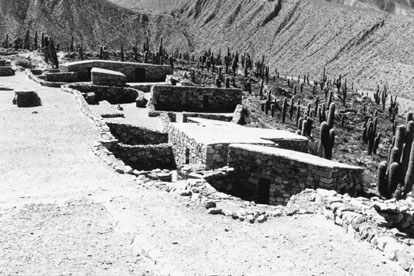

 | Page 108 |  |
use the methods of the Vienna school. In 1936 the Sociedad Argentina de Antropología was created, with only ten members; Outes served as its first president. This society arranged a number of important scientific meetings—the Semana de Antropología—for the discussion of anthropology and archaeology.

Section of the Pucará de Tilcara, Jujuy
(Photo by Noel Montoya)
During the economic depression of the 1930s, and throughout World War II, archaeology and prehistory courses were given at other universities such as Rosario, Cuyo, Tucumán, and Córdoba, resulting in a significant increase in the number of researchers and research projects. In addition, archaeological investigations of whole new areas were launched—in the Mesopotamia regions by Serrano and de Aparicio and in Cuyo by Canals Frau and Semper. However, most of the fieldwork was still done in the northwest; the least was done in the Pampas and Patagonia.
During the post–World War II period Argentine archaeology flourished. This was the consequence of the work of Wendell C. Bennett and A.R. González in the northwest and the arrival in Buenos Aires of O. Menghin. After 1955, with the advent of radiocarbon dating, more-regional explanations of archaeological variation were discussed. Between 1950 and 1960 both the University of Buenos Aires and the University of La Plata began to teach anthropology and to specialize in archaeology, definitively incorporating both in an Argentine university degree. Other universities followed their example over the next decades.
The work of González and Menghin characterized Argentine archaeology after the 1960s. González, working in the northwest, and Menghin, working first in the Pampas and later in Patagonia, resolved the theoretical framework for each region, and their studies were followed up by other archaeologists, such as Cigliano, Bórmida, Schobinger, and Lafon. However, they also represented two opposing traditions and schools of thought: González the North American culture-history school and Menghin the Vienna school. Both of them established general regional chronologies that would be used for the next forty years.
The Argentine national government became
 |  |